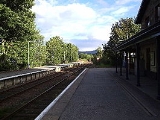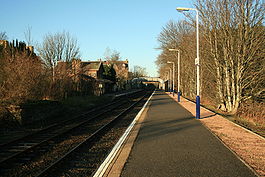
Ardgay railway station
Encyclopedia

Ardgay
Ardgay is a small Scottish village on the north west shore of the Dornoch Firth, Sutherland and lies at the entrance to Strathcarron, the valley of the River Carron. In the Highland Council area Ardgay is in Ward 1, the North, West and Central Sutherland ward.Ardgay is served by the Ardgay...
in the Highland
Highland (council area)
Highland is a council area in the Scottish Highlands and is the largest local government area in both Scotland and the United Kingdom as a whole. It shares borders with the council areas of Moray, Aberdeenshire, Perth and Kinross, and Argyll and Bute. Their councils, and those of Angus and...
council area of Scotland
Scotland
Scotland is a country that is part of the United Kingdom. Occupying the northern third of the island of Great Britain, it shares a border with England to the south and is bounded by the North Sea to the east, the Atlantic Ocean to the north and west, and the North Channel and Irish Sea to the...
. The station is on the Far North Line
Far North Line
The Far North Line is a rural railway line entirely within the Highland area of Scotland, extending from Inverness to Thurso and Wick.- Route :...
, 93 km (57¾ miles) north of Inverness
Inverness railway station
Inverness railway station is the railway station serving the Scottish city of Inverness.- History :Opened on 5 November 1855 as the western terminus of the Inverness and Nairn Railway, it is now the terminus of the Highland Main Line, the Aberdeen-Inverness Line , the Kyle of Lochalsh Line and the...
, near Bonar Bridge
Bonar Bridge
Bonar Bridge is a village on the north bank of the Kyle of Sutherland, in the Parish of Creich in the Highland council area of Scotland.The Kyle of Sutherland is a river estuary of the Rivers Oykel, Cassley, Shin and Carron that all enter the Kyle above the bridge at Bonar.The estuary and the...
. Ardgay station has a passing loop
Passing loop
A passing loop is a place on a single line railway or tramway, often located at a station, where trains or trams in opposing directions can pass each other. Trains/trams in the same direction can also overtake, providing that the signalling arrangement allows it...
, the next loop to the south being at and to the north, .
History
Opened on 1st. October, 1874 as Bonar Bridge, by the Inverness and Junction Railway, it became the meeting point of the Sutherland RailwaySutherland Railway
The Sutherland Railway was a railway worked by, and later absorbed in 1884 by the Highland Railway running through Sutherland, Scotland. Sutherland is a former county, and former districts of the Highland region....
and the Inverness and Ross-shire Railway
Inverness and Ross-shire Railway
The Inverness and Ross-shire Railway was incorporated on 3 July 1860 with the aim to build a line to Invergordon. The line opened in stages:* 11 June 1862 - Inverness to Dingwall* 23 March 1863 - Dingwall to Invergordon...
. The station joined the Highland Railway
Highland Railway
The Highland Railway was one of the smaller British railways before the Railways Act 1921; it operated north of Perth railway station in Scotland and served the farthest north of Britain...
, later becoming part of the London, Midland and Scottish Railway
London, Midland and Scottish Railway
The London Midland and Scottish Railway was a British railway company. It was formed on 1 January 1923 under the Railways Act of 1921, which required the grouping of over 120 separate railway companies into just four...
during the Grouping
Railways Act 1921
The Railways Act 1921, also known as the Grouping Act, was an enactment by the British government of David Lloyd George intended to stem the losses being made by many of the country's 120 railway companies, move the railways away from internal competition, and to retain some of the benefits which...
of 1923, it then passed on to the Scottish Region of British Railways
Scottish Region of British Railways
The Scottish Region was one of the six regions created on British Railways and consisted of ex-London, Midland and Scottish Railway and ex-London and North Eastern Railway lines in Scotland...
on nationalisation in 1948. It was renamed Ardgay on 2nd. May 1977.
When Sectorisation
British Rail brand names
British Rail was the brand image of the nationalised railway owner and operator in Great Britain, the British Railways Board, used from 1965 until its breakup and sell-off from 1993 onwards....
was introduced in the 1980s, the station was served by ScotRail
ScotRail
ScotRail was a brand name used for all Scottish regional and commuter rail services, including some cross-border services, from 1997 to 2004....
until the Privatisation of British Rail
Privatisation of British Rail
The privatisation of British Rail was set in motion when the Conservative government enacted, on 19 January 1993, the British Coal and British Rail Act 1993 . This enabled the relevant Secretary of State to issue directions to the relevant Board...
ways.
Today Ardgay is the termination point for some commuter services from Inverness. The southbound platform is twice the length of the northbound platform.

